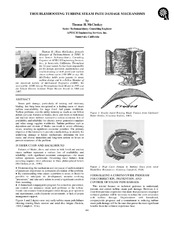| dc.contributor.other | Turbomachinery Symposium (31th : 2002) | |
| dc.creator | McCloskey, Thomas H. | |
| dc.date.accessioned | 2017-10-04T23:57:11Z | |
| dc.date.available | 2017-10-04T23:57:11Z | |
| dc.date.issued | 2002 | |
| dc.identifier.uri | https://hdl.handle.net/1969.1/163306 | |
| dc.description | Tutorial | en |
| dc.description | pg. 105-144 | en |
| dc.description.abstract | Steam path damage, particularly of rotating and stationary blading, has long been recognized as a leading cause of steam turbine unavailability for large fossil fuel plants worldwide. Turbine problems cost the utility industry as much as one billion dollars per year. Failures of blades, discs, and rotors in both fossil and nuclear steam turbines represent a serious economic loss of availability and reliability for electric power generation suppliers and other energy supplies worldwide. Turbine problems such as deposition and erosion of blades can result in severe efficiency losses, resulting in significant economic penalties. The primary objective of this tutorial is to provide a methodology to identify the underlying damage or failure mechanisms, determine the root cause, and choose immediate and long-term actions to lessen or prevent recurrence of the problem. | en |
| dc.format.medium | Electronic | en |
| dc.format.mimetype | application/pdf | |
| dc.language.iso | en | |
| dc.publisher | Texas A&M University. Turbomachinery Laboratories | |
| dc.relation.ispartof | Proceedings of the 31st Turbomachinery Symposium | en |
| dc.subject.lcsh | Turbomachines | en |
| dc.title | Troubleshooting Turbine Steam Path Damage Mechanisms. | en |
| dc.type.genre | Presentation | en |
| dc.type.material | Text | en |
| dc.identifier.doi | https://doi.org/10.21423/R1DM1K | |


